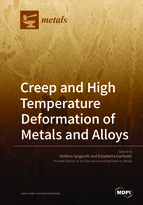Creep and High Temperature Deformation of Metals and Alloys
A special issue of Metals (ISSN 2075-4701). This special issue belongs to the section "Metal Failure Analysis".
Deadline for manuscript submissions: closed (30 June 2019) | Viewed by 54501
Special Issue Editors
Interests: creep; high-temperature deformation and hot working; steels; light alloys; metal matrix composites
Special Issues, Collections and Topics in MDPI journals
Interests: high temperature mechanical behavior; creep; high temperature microstructural stability; aluminum alloys
Special Issues, Collections and Topics in MDPI journals
Special Issue Information
Dear Colleagues,
The occurrence of time-dependent deformation of metals and alloys under constant loads or stresses, a phenomenon termed “creep”, has been documented for at least two centuries. Yet, its real significance was appreciated only by the late 1940s, when some peculiar features of creep, such as the occurrence of plastic deformation under stresses well below yielding, were investigated in detail. The continuous development of dislocation theories later permitted to enlighten some specific features of creep deformation. Similarly, the same dislocation theories were used to provide a physical background to the study of metals and alloys response to hot working processes and also to explain and model stress relaxation effects. In parallel, many new creep-resistant materials have been developed, and new hot-working techniques introduced, but creep and hot-working studies proceeded, in most cases, independently of each other. Yet, in many cases, the mechanisms that control these phenomena are essentially the same.
The aim of this Special Issue is to highlight recent innovations introduced in the fields of creep and, from a wider perspective, on high-temperature deformation. Scholars are thus encouraged to submit research papers dealing on specific aspects of creep and high-temperature deformation or describing the response of metals and alloys by experimental techniques and/or modelling.
Prof. Dr. Stefano SpigarelliProf. Dr. Elisabetta Gariboldi
Guest Editors
Manuscript Submission Information
Manuscripts should be submitted online at www.mdpi.com by registering and logging in to this website. Once you are registered, click here to go to the submission form. Manuscripts can be submitted until the deadline. All submissions that pass pre-check are peer-reviewed. Accepted papers will be published continuously in the journal (as soon as accepted) and will be listed together on the special issue website. Research articles, review articles as well as short communications are invited. For planned papers, a title and short abstract (about 100 words) can be sent to the Editorial Office for announcement on this website.
Submitted manuscripts should not have been published previously, nor be under consideration for publication elsewhere (except conference proceedings papers). All manuscripts are thoroughly refereed through a single-blind peer-review process. A guide for authors and other relevant information for submission of manuscripts is available on the Instructions for Authors page. Metals is an international peer-reviewed open access monthly journal published by MDPI.
Please visit the Instructions for Authors page before submitting a manuscript. The Article Processing Charge (APC) for publication in this open access journal is 2600 CHF (Swiss Francs). Submitted papers should be well formatted and use good English. Authors may use MDPI's English editing service prior to publication or during author revisions.
Keywords
- Creep
- Hot working
- Constitutive equations
- Creep mechanisms
- Microstructural features
- Microstructural stability
- Steels
- Nickel-base superalloys
- Light Alloys
- Composites







